Brief

At a Glance
- The focus on biodiversity is growing among businesses, investors, regulators, and consumers.
- Measuring biodiversity impact and the value of responses remains challenging for businesses, but first movers already are leading the way.
- Most efforts focus on opportunities in regenerative agriculture, nature-friendly products and design, circularity, and nature-based decarbonization.
- Companies can start their biodiversity strategy by first assessing their own risks and impacts, as well as the potential for business opportunities.
Biodiversity is a word that is being heard with increasing frequency in corporate boardrooms as business leaders come face-to-face with their responsibility to stem the escalating effects of nature degradation and to just as aggressively pursue the substantial business upside that can be achieved in the process.
In fact, 2023 may be remembered as the year that Nature Positive joined Net Zero as a corporate imperative. The UN-brokered Global Biodiversity Framework (GBF), which some call the “Paris climate accords for nature,” was adopted late last December, days after the European Parliament reached a preliminary deal with EU governments on a first-of-its-kind deforestation-free regulation for supply chains of cocoa, coffee, soy, wood products, palm oil, rubber, and cattle.
Those were two major steps in a rapid succession of new reporting and regulatory requirements aimed at reversing losses in nature’s level of diversity in species, plants, and ecosystems. In January, the Global Reporting Initiative (GRI) started work to update its biodiversity standard. In March the UN High Seas Treaty was finalized. In May, the Science-based Targets Network (SBTN) launched the first corporate standards for freshwater and land, with 17 multinationals committing to pilot the target validation process. And in the remaining months of 2023, the International Sustainability Standards Board (ISSB) will do further work on biodiversity requirements, and the Taskforce on Nature-related Financial Disclosures (TNFD) is expected to finalize its framework. Meanwhile, regulations are on the agenda everywhere, from Australia to Canada to Costa Rica to Singapore.
Indeed, biodiversity pressures are quickly reaching a tipping point. Investors are looking to ensure their holdings are addressing nature risks; the Finance for Biodiversity Pledge now has 140 signatories. In addition to investors, banks such as HSBC and BNP Paribas have developed biodiversity lending and investment products. And business alliances such as World Business Council for Sustainable Development and organizations such as the World Economic Forum, which engaged on climate, now are also embracing biodiversity.
At the same time, a growing segment of consumers, especially in iconic industries like food, fashion, and beauty, is rewarding businesses that invest in biodiversity efforts—and rejecting companies that don’t. More and more products bear messaging designed to appeal to consumer concerns for nature. Consider these words used on the Natura beauty website: “thanks to Natura [EKOS] products and the work of these [Brazilian farming] communities, 1.8 million hectares of forest have been conserved for sustainable resource use and a better future for generations to come.” When one European dairy business appealed to customers with such biodiversity-oriented messaging, engagement rose by 20%.
If this sounds familiar, it’s because the approaches used to spur global business mobilization around nature and biodiversity loss are the same approaches used to generate action for climate change. That’s why this movement is gathering momentum so quickly—and gaining attention faster than many business leaders had anticipated.
Climate and biodiversity are directly connected. Climate change is one contributor to biodiversity loss, yet measures to improve biodiversity—such as renaturation of moors or protecting forests—have a positive effect on climate. However, not all carbon transition measures help biodiversity. For example, wind parks and infrastructure built for hydrogen power often negatively impact local biodiversity. While climate change is relatively easy to measure based on temperature and atmospheric greenhouse gas (GHG) levels, biodiversity has numerous factors such as location specificities, complex system dynamics, and lack of historical baselines that make it significantly harder to measure and monitor.
These complexities also make the solution sets for biodiversity harder to design. We do expect that a common language, measurement system, and targeting approach for biodiversity will be resolved over the coming years, though it may be slow going. Consider how long it’s taking to agree on carbon Scope 3 and how that should be measured and reported.
A world at risk
As with climate change, the big push to tackle biodiversity and nature loss is long overdue. The world has seen species populations drop by nearly 70% since 1970 (while the human population has more than doubled). The World Economic Forum estimates that $44 trillion of economic value, equivalent to more than 50% of the global GDP, is at risk if nature degradation is not reversed before 2030. This impact can come through such well-documented issues as falling agricultural yields in dying soils and lower fertilization rates of plants from decimated bee populations, for example. While the effects are being felt harder in such regions as Southeast Asia, Latin America, and the Mediterranean basin, biodiversity loss eventually impacts everyone, everywhere.
Three big economic systems are the major contributors to the growing losses in nature and biodiversity (see Figure 1). The biggest among them is the food, fiber, and biofuel system, which is responsible for almost three-quarters of threatened species (one way to measure impact) through deforestation and water and soil pollution.
Three socioeconomic systems are causing the majority of nature loss
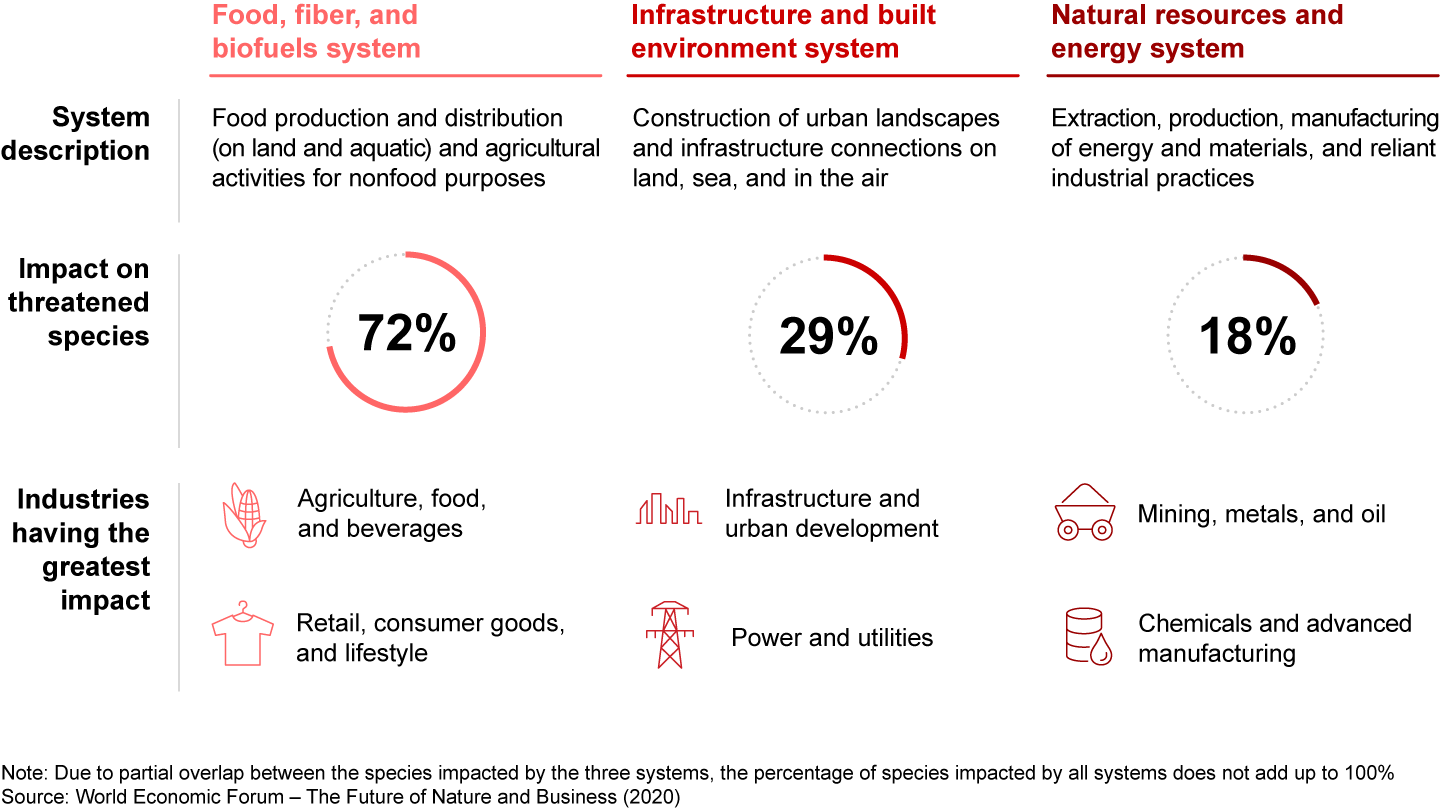
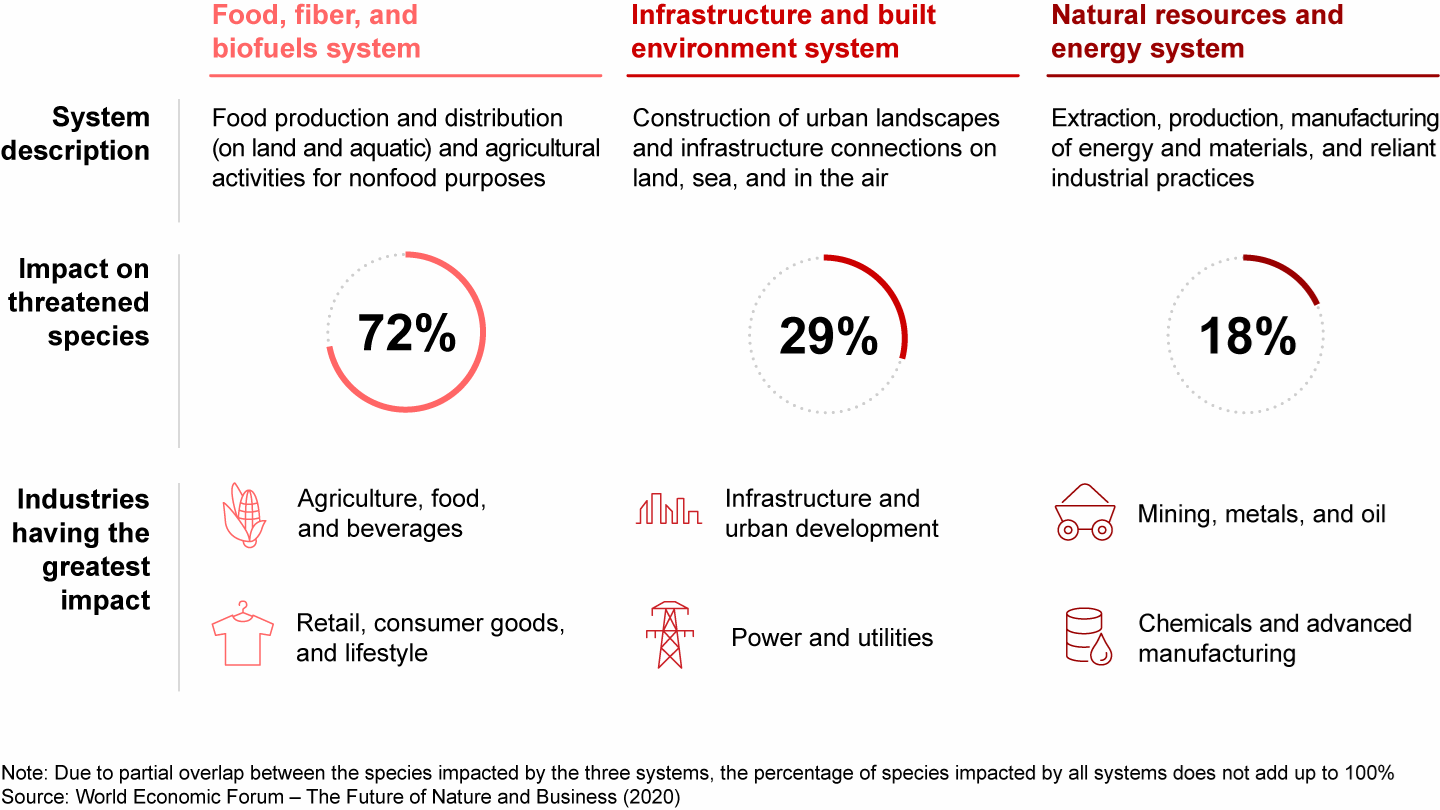
In addition, the infrastructure and built environment system contributes to the degradation of land and seabeds, for example, impacting almost 30% of threatened species. Finally, the natural resources and energy system contributes to such issues as habitat destruction and landscape alterations, affecting 18% of threatened species.
The corporate response
For business, the biodiversity imperative comes with risks and opportunities. On the one hand, companies need to prepare to mitigate such risks as disrupted supply chains, regulatory concerns, and diminished brand equity. Some of the risks are quite fundamental to their future existence. What happens, say, when a major coffee producer can’t get enough beans due to dwindling global yields? On the other hand, addressing biodiversity can set companies up to grow in new directions, such as agriculture input firms developing new types of seeds or fertilizers for biodiversity-fragile areas.
Yet executives tell us they encounter four basic barriers in drafting a biodiversity strategy.
For one thing, while many business leaders are aware of the extent of biodiversity loss in general, a significant number are unaware of their own company’s impact and exposure. Among 88 companies in Finland and Sweden we surveyed, around 60% claimed to have no impact on biodiversity and more than half didn’t perceive biodiversity loss as a large threat for their business. It’s a situation that is likely to change as more data becomes available over the next three to five years to create transparency, more robust targets, and better monitoring. As it has with climate issues, the data and software-as-a-service ecosystem for biodiversity is evolving, with such moves as CDP adding biodiversity questions in 2022 and the emergence of start-ups to help with data gathering, measurement, and reporting.
A second barrier: Companies find it difficult to show the potential value that can be generated from addressing biodiversity loss. While around 25% of the surveyed companies claim to be generally aware of biodiversity-related business opportunities, almost all those respondents say they lack enough depth and detail into those opportunities to justify the investment.
Companies also have been slowed by the nascency of biodiversity standards in the corporate context. Despite the rush to create regulations and reporting requirements, the evolving standards still await finalization. Many companies don’t want to move concretely until they know what will really be considered important and how to measure it.
Finally, corporate efforts are stymied by a gap in available financing. According to the Paulson Institute, current annual financing (public and private) for biodiversity has been up to $143 billion, far short of the $967 billion required to meet the upper limits through 2030.
The net result of these barriers? Research conducted by CDP found that only 15% of companies have assessed the impact of their value chain on biodiversity, either upstream, downstream, or both (see Figure 2). And only 32% have published information on their response to biodiversity-related issues. In fact, around 40% of the respondents in Bain’s research told us that their sustainability strategies have no initiatives that specifically address biodiversity. Activity does vary substantially by industry. For example, power and utility companies are ahead of the curve in such moves as publishing information on their biodiversity response, taking specific actions to address biodiversity loss and establishing biodiversity indicators for performance management. By comparison, companies in retailing, chemicals, and manufacturing are much less developed in these and other actions.
Businesses are increasingly starting to commit to action, yet remain uncertain on where to focus and how to measure
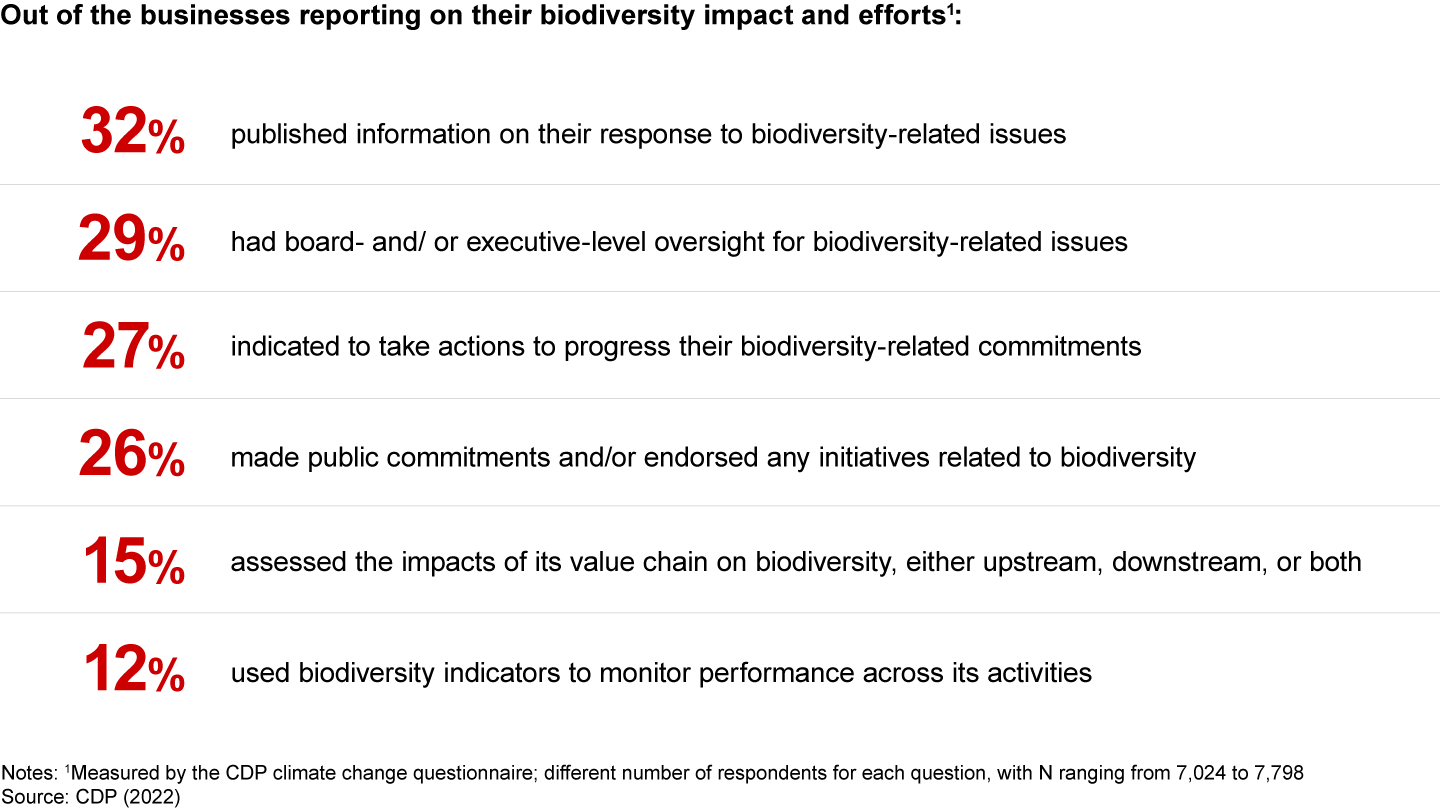
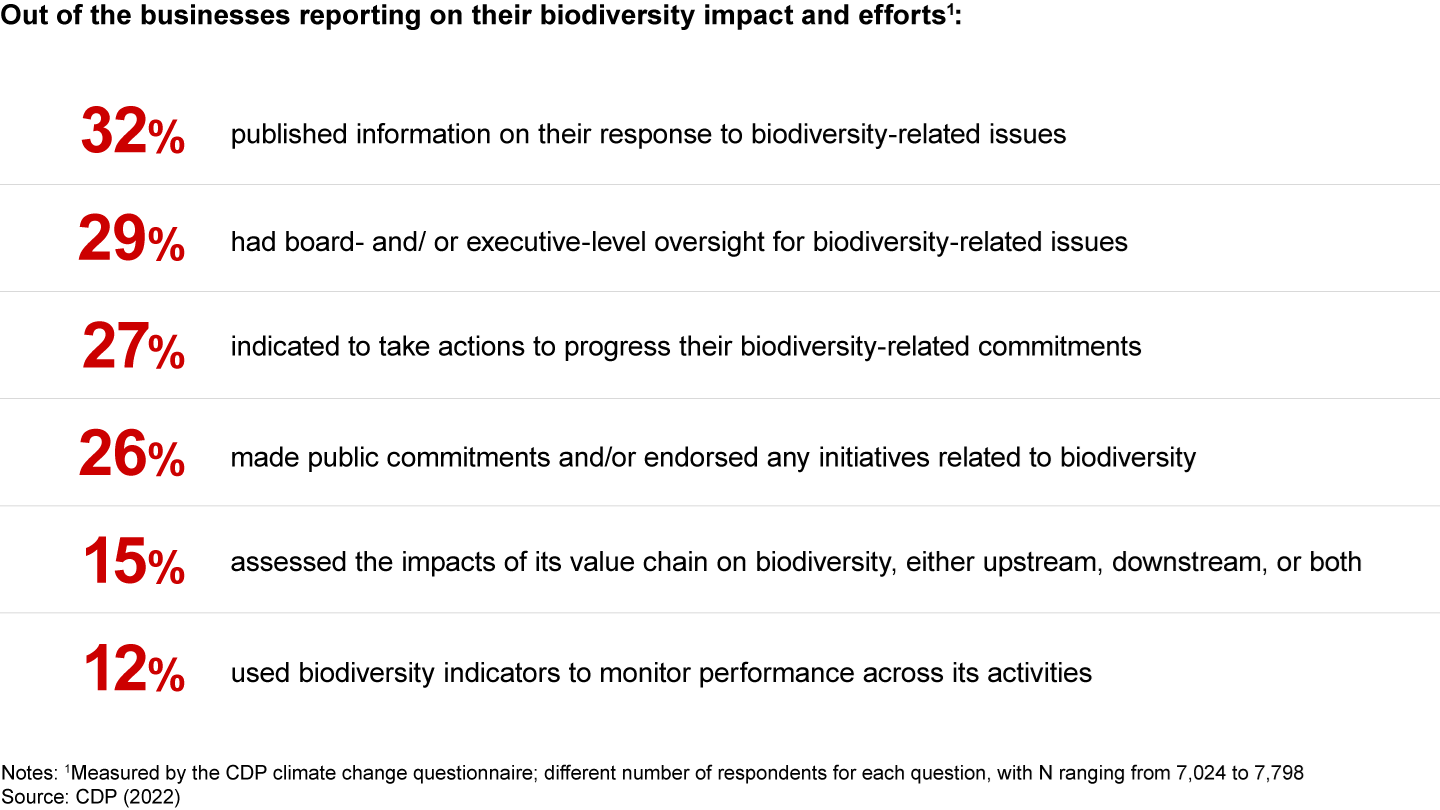
The emergence of early movers
Some companies have been comparatively quick to act. For example, Nestlé already achieved a 99.1% deforestation-free supply chain in 2022 in everything from palm oil to pulp while also setting a course for sourcing half of its key ingredients through regenerative agricultural methods by 2030. Similarly, L’Oréal aims to transform its supply chain so that by 2030, 100% of biobased ingredients will be traceable and from sustainable sources while 95% of its ingredients will be biobased, derived from abundant minerals or from circular processes. The first company to build an offshore wind farm, Danish energy producer Ørsted set a goal to deliver a net-positive biodiversity impact from all new renewable energy projects it commissions from 2030 at the latest.
Europe’s largest private forest owner, SCA, set aside more than 160,000 hectares of its productive forest land for conservation measures, defining critical habitat categories required to retain 203 threatened species by adapting harvesting methods or setting aside areas to remain unharvested. The company’s measures to promote species survival in a more stable and resilient forest benefit the company with a higher diversity of raw materials for new product innovation. SCA has managed to increase its standing timber volume and sustainable harvesting level substantially, according to the company.
Finding the opportunity
The best companies will take a systematic approach to the biodiversity imperative—setting strong ambitions and taking accountability, getting started quickly to build change muscle, and then launching longer-term actions across the value chain. Often, they can accelerate by leveraging existing climate initiatives. One easy step can be to work through how nature and biodiversity can be incorporated into net-zero plans. One residential real estate player, for example, was looking at technical solutions (e.g., orientation of windows, smart shading) to reduce air conditioning needs. The company determined that adding more trees to a real estate project also contributes to reducing building temperatures, cutting carbon while bolstering biodiversity.
Critically, leaders will look for ways that biodiversity action can serve as a catalyst for profitable growth. Biodiversity opens $10 trillion in business opportunities for companies that adopt biodiversity-positive business models by 2030, according to the World Economic Forum.
That upside potential covers everything from nature-friendly products to safe and clean energy sources to circular economy models such as sharing platforms that take the pressure off resource extraction. As an example of the business opportunities, Unilever is on track to generate €1.5 billion of sales per year from plant-based offerings that replace animal-derived proteins, a move that can substantially curtail deforestation and other biodiversity ills. This is a win-win-win—great for carbon, great for biodiversity, and great for the bottom line. The residential developer found the same; more greenery enhanced not just carbon and nature, but also livability, creating a stronger value proposition for its customers.
Biodiversity’s five key movements
While a full spectrum of solutions is available to business leaders, our research found that most opportunities cluster into five key movements.
Regenerative agriculture. Converting agricultural practices and principles to improve soil health and other sustainability indicators can deliver a nearly 50% cut in emissions and may improve bird diversity in an area while boosting margins by 30%, according to our estimates. In 2020, General Mills commissioned a Soil Return on Investment study that found that for every $1 contributed to regenerative agriculture, roughly $5 would be generated in additional social, environmental, and economic value. After starting with a 50,000-acre pilot, the company committed to advance regenerative agriculture for 1 million acres by 2030.
The packaged goods company has funded research and technical support for farmers adopting regenerative farming, signed a deal to purchase certified organic regenerative wheat, and supports the measurement and certification of greenhouse gas emissions and water quality improvements. Moreover, General Mills has supported a carbon credit program, Eco-Harvest, to add a second revenue stream to regenerative agriculture on top of its crop sales.
Even without fully shifting to regenerative techniques, companies can make major biodiversity strides in their natural material supply chains. At IKEA, more than 98% of the wood used for IKEA products now is either Forest Stewardship Council–certified or recycled. The company has set a series of ambitious goals, such as ensuring that by 2025, its high-deforestation-risk raw materials (mostly wood products, leather, and rubber) are deforestation-free. And Nestlé will be using Airbus’s new Pléiades Neo satellites to monitor its reforestation efforts.
Nature-compatible products. Some innovations recently introduced for other environmentally friendly reasons also can be good for biodiversity, highlighting the potential for using biodiversity as another lens when considering innovation. The growth of natural beauty products and nature-friendly pesticides have overlap effects with biodiversity improvement. Biological products such as biofertilizer and bioherbicides are expected to grow from a $400 million in revenues business in 2020 to $1.9 billion in 2030. Even more on the cutting edge, building companies are experimenting with green materials like cross-laminated timber as a sustainable alternative to steel and cement.
Nature-positive systems design. For big infrastructure and development projects, the biodiversity goal is to bring an understanding of nature into their design. Take the built environment, for example. The ultimate objective is to design greener cities and infrastructure projects in a way that respects nature. On World Earth Day 2022, work began on the $90 million Wallis Annenberg Wildlife Crossing near Los Angeles. It’s a freeway overpass that will allow big cats, deer, snakes, lizards, and other creatures to bypass one of the busiest highways in the country. Upon completion in early 2025, it will be the largest wildlife bridge in the world.
Enel, an Italian manufacturer and distributor of electricity and gas in 30 countries, has committed to achieving no net loss of biodiversity for new infrastructure by 2030. It plans to implement a No Net Deforestation principle by 2030 and to not build new infrastructures in UNESCO World Heritage Natural Sites. To achieve these targets, Enel is actively investing in a variety of species-conservation projects, supporting the United Nations Biodiversity Conference (COP15) business forum’s targets and developing biodiversity projects, according to the company.
Circular material flows and business models. As materials extraction is responsible for much of biodiversity loss, anything that keeps already extracted materials in use longer will be beneficial to natural environments. One of the largest manufacturers of carpet tiles, Interface has made big strides in carpet reclamation. The company reports that it has so far collected over 300 million pounds of carpet, of which at least 20 million pounds has been recycled or repurposed. All of this has avoided the need for more virgin materials with extractive methodologies that can harm nature.
High-quality nature-based solutions. More companies are looking for ways to buy offsets as part of their decarbonization strategy—but they also can demand that those offsets have benefits to biodiversity. Restoring, conserving, and optimizing ecosystems to preserve nature and biodiversity can contribute around 35% of the carbon mitigation required to limit global warming. Here, companies are pursuing climate actions that also improve biodiversity.
Re.Green is a Brazilian company that has signed agreements with buyers of carbon credits to finance the large-scale restoration of the Amazon rainforest using diverse and native species. L’Oréal recently announced a €50 million Fund for Nature Regeneration that is implemented with asset management company Mirova Natural Capital. And in Indonesian Borneo, large reforestation efforts are aiming to protect endangered local wildlife and species such as the Bornean orangutan and the proboscis monkey. Among those projects, Rimba Raya in Central Kalimantan has issued 33 million carbon credits.
How to build a more nature-positive business
Companies can take a structured, strategic approach to defining the role of nature and biodiversity in their agenda and initiating the right actions.
Start with a baseline assessment. To get a handle on their unique situation, companies can conduct a materiality and baseline assessment to determine their risks, impacts, and dependencies on nature. Such an assessment gives corporations an in-depth understanding of biodiversity issues and provides the basis for their overall biodiversity strategy. It’s a complex endeavor, and business leaders often find it daunting even to begin. However, companies have many frameworks to guide their efforts. One that is gaining traction is the TNFD “Leap” approach. (The steps are: locate the interface with nature, evaluate dependencies and impacts, assess material risks and opportunities, and prepare to respond and report.)
It is critical that companies take a full value chain view of biodiversity. As with carbon, where Scope 3 emissions are often the biggest share, the largest biodiversity impacts are usually found up- or downstream in the value chain.
Assess the potential for value creation. To determine how to make biodiversity efforts a source of profitable growth, companies can identify which of the possible nature-positive business models will deliver a financial upside—and the short-term transitions that can be executed to implement those business models. The answer will be different for different industries (see Figure 3). For example, retailers and consumer goods companies would look for opportunities in nature-compatible products and circular business models. Natural resources companies are starting to tap into the value of carbon and nature markets.
Different industries need to focus on different transitions in the short term, as their potential to drive change differs across the transitions
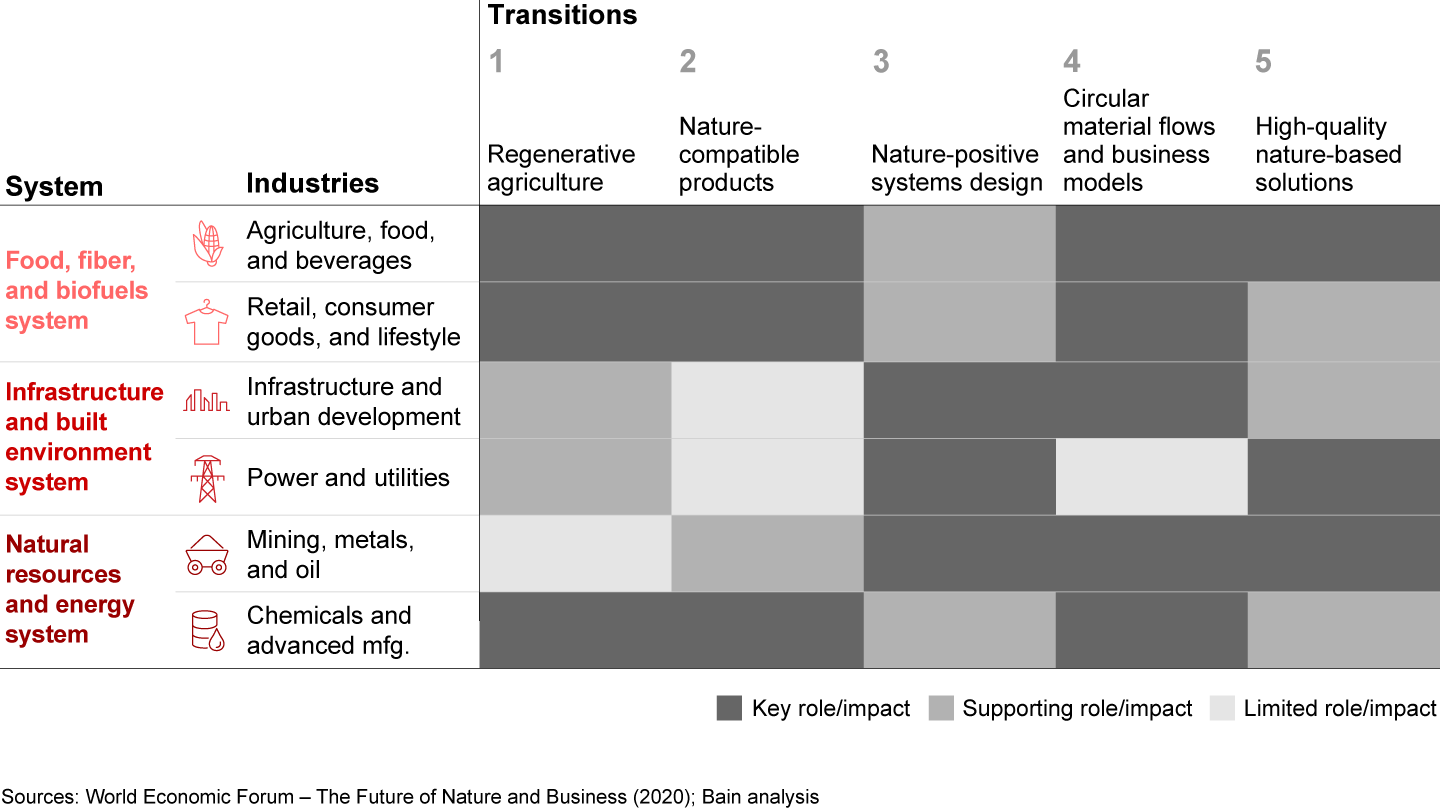
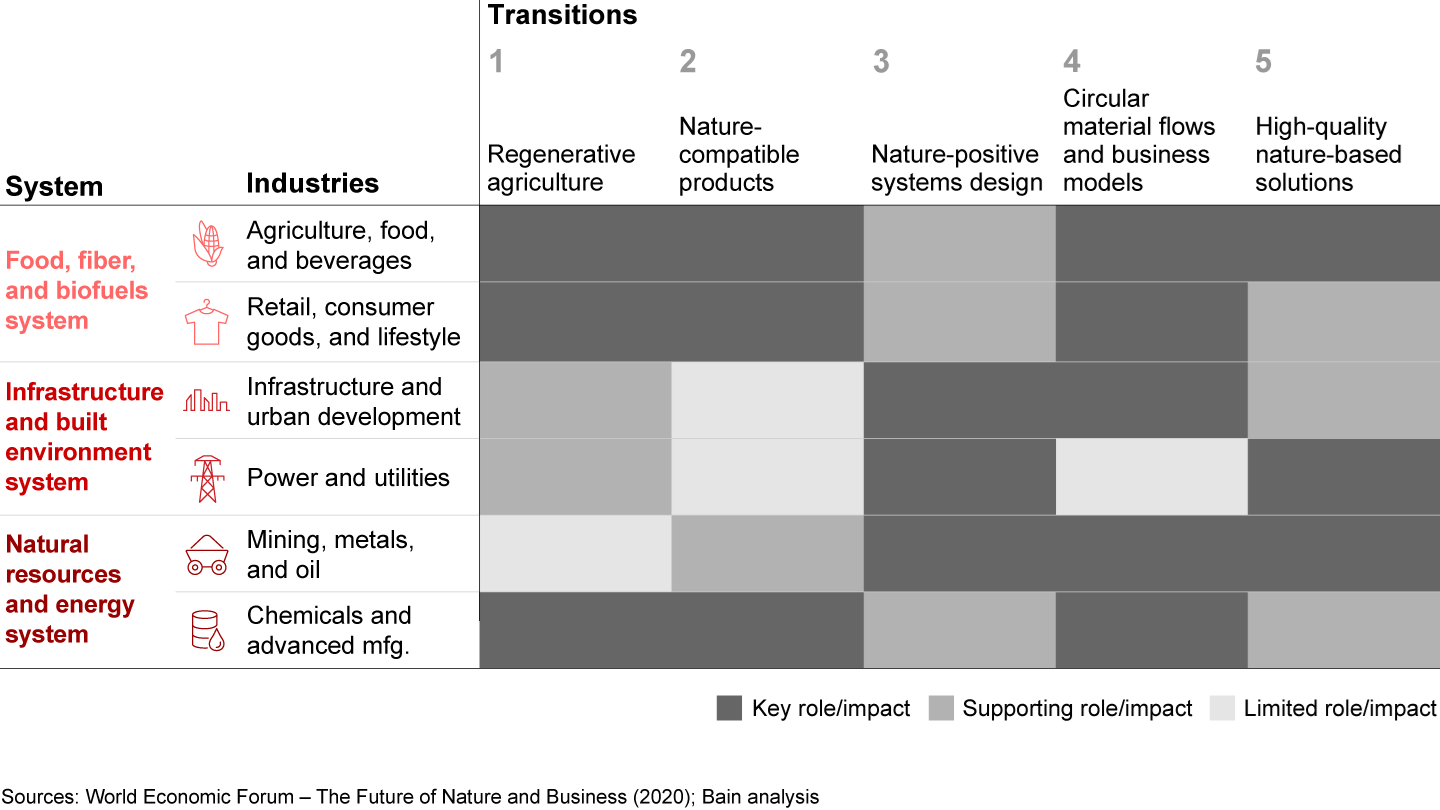
Banks, which have mapped transition finance opportunities for climate, for example, are using this same approach to biodiversity. Where industries have to take steps to become nature positive, banks can cultivate profitable businesses.
Plot an integrated strategy. The baseline and value creation assessments can set a company up for developing a long-term, integrated strategy. Four questions can help guide business leaders as they embark on this often-challenging process.
- How bold and fast should my ambition be across biodiversity spheres?
- On which parts of my business should I focus, what are the available strategic and operational levers, and how should I prioritize them over time?
- How should I adjust my organization and governance to drive a lower impact on biodiversity in a sustainable way?
- How should I engage investors, suppliers, customers, peers, and other stakeholders in the ecosystem to support the shift to a nature-positive business model?
As they plot their integrated strategy, companies still need to keep on top of fast-moving requirements and options. Some benefit by partnering with alliances that develop regulatory and reporting frameworks and tools, or by working with those organizations to develop solutions.
To help it understand the science and solutions that will bring it to net-positive biodiversity impact goals, wind energy pioneer Ørsted teamed with the World Wildlife Fund (WWF). In a five-year project, Ørsted and WWF are working together to explore methods of restoring the flat oyster and horse mussel populations while Ørsted quickly increases the number of offshore windfarms it builds. Both species are “ecosystem builders,” creating biogenic reefs that allow living creatures to find shelter, breeding, and hunting room. The aim of the project is to establish protocols to develop and maintain the two species in the wild, while also building biogenic reefs.
As sustainability leaders like Ørsted embark on the challenging process of rebuilding complex ecosystems, and as they invest in other ways to reverse nature and biodiversity loss, they also set themselves up to reap the enduring rewards of a nature-positive company.